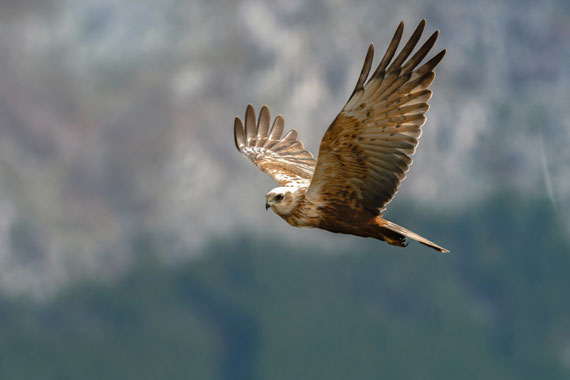Birds are majestic creatures, able to take flight, soaring high in the sky. One of the longest recorded non-stop bird flights was an astonishing 8,100 miles, achieved by a bar-tailed godwit (Limosa Iapponica). Photographs of birds in flight can be equally as impressive — something Simon d’Etremont, a pro wildlife photographer, knows all about! In his latest tutorial, he details how to go about shooting birds in their natural habitat — flying in the sky.
Simon’s Gear & Settings:
On this particular shoot, Simon’s capturing some of the fastest-flying birds, puffins, which can move at up to 90 mph. That’s why he advises using a powerful lens and having your camera settings set up before heading out.
Camera: Canon EOS R5 & R6.
Lens: Canon EF 500mm f/4L IS II USM and Canon EF 100-400mm f/4.5-5.6L IS II USM.
Focus mode: Auto-focus continuous (AFC) or AI Servo (on Canon). If you have a mirrorless camera, autodetect or 3D tracking is ideal.
Focus points: Select as many central focus points as possible. Simon’s preference is nine central AF points (9×9) on his Canon setup.
Burst mode: Burst of 12 fps or more. If your camera tends to run slowly when writing the images to your card, then try shooting in periodic bursts.
Priotize Shutter Speed
Undoubtedly one of the most important settings is shutter speed when shooting fast-flying birds. Simon offers a variety of tips on how to optimize your lens and camera’s shutter speed:
- Adjust your shutter speed just enough to freeze the action, but not too much to avoid a high ISO.
- Large birds fly slow, smaller birds faster, so vary shutter speed based on the target. Simon suggests 1/1000 to 1/1250 for large birds, 1/2000 – 1/2500 for medium-sized birds, and 1/3200 – 1/4000 for small birds.
- When bird wings are facing all the way down or up, you can use a lower shutter speed as there is less movement.
- Manual or shutter priority are best to shoot birds in flight. Simon’s personal favorite is manual with auto ISO and exposure compensation.
- Don’t use image stabilization on Nikon cameras with a shutter speed of 1/2000+ if you want a sharp image. However, Simon has no issue shooting at higher shutter speeds on his Canon setup.

Photo captured by Emanuel Antonov; 350mm, ISO 200, f/5.6, 1/1000s.
Don’t Forget to Pan
Some cameras feature stability modes, pan being the most useful for photographing flying birds. This setting only stabilizes up or down, not left and right movement. Besides camera settings, your panning technique also matters. Simon advises tucking in your elbows and pan using your whole body, not just your arms. Also, always keep the target in the same spot in your camera viewfinder.
Watch for Signs
It’s important to be prepared when shooting birds — not only do they fly fast. They also land and take off equally as quickly, meaning you may miss that perfect shot if you’re not always at the ready. Birds take off in the direction of oncoming wind, just like planes, so you want to aim there. Alternatively, when shooting landing birds, put the wind to your back. Simon suggests auto-focusing on the location you expect the bird to land beforehand and to look out for bird behaviors.
There are signs that birds might be ready to take off that’ll help you get ready… that includes puffing just before taking off…
Shoot for Composition
You may get so focused on capturing flying birds that you forget about your composition. Simon has a few tips to remedy this, including keeping the bird in the back of the frame. This ensures shots taken feature an empty space for them to “fly” into — which looks more appealing and avoids risking cutting off a wing or losing the bird.
Other top tips include shooting at eye level and using colorfully diverse land or sea as alternative backgrounds to the sky. It’s important to reduce busyness by ensuring backgrounds are 100 yards or more away. Of course, you also want to shoot on a sunny day. Preferably with your back to the sun to ensure optimum illumination of the bird at high shutter speed.
Conclusion:
Shooting flying birds may be a daunting task. However, you can employ various effective strategies to capture them perfectly. Simon possesses a trove of know-how on the topic, including the insightful tips shared in his video.
- - - - - - - - - - - - - - - - - - - - - - - - - - - - - - - - - - - - - - - - - - - - - - - - - - - - - - - - - - - - - - - - - - - - - - - - - -
Did you appreciate this newsletter? Please help us keep it going by Joining Our Patreon Supporters
What are your thoughts on this article? Join the discussion on our Facebook Page
PictureCorrect subscribers can also learn more today with our #1 bestseller: The Photography Tutorial eBook
- - - - - - - - - - - - - - - - - - - - - - - - - - - - - - - - - - - - - - - - - - - - - - - - - - - - - - - - - - - - - - - - - - - - - - - - - -
The post Birds in Flight Photography Tutorial appeared first in the Photography Tips category on PictureCorrect.
from PictureCorrect https://ift.tt/Hm13UMn
via IFTTT






0 kommenttia:
Lähetä kommentti